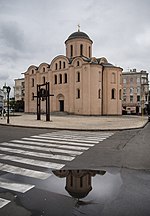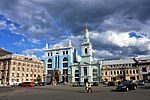Podilskyi District

The Podilskyi District (Ukrainian: Подільський район) is an urban district of Kyiv, the capital of Ukraine. Its population was 177,563 at the 2001 census. The district takes its name from the historic Podil neighborhood which it includes within its boundaries. The Podilskyi District as an administrative entity was formed in 1921 on one of the largest historical neighborhoods in Kyiv. In May 2001 the Podilskyi District celebrated the 80th anniversary of its foundation. The district remains one of the main business, transport, and industrial areas of Kyiv. There are currently 50 large industrial organizations based here. Although most of the industrial sites are phased out of the region, they dominate the adjacent neighborhoods to the north, named today "Podilsko-Kurenivskiy promraion".
Excerpt from the Wikipedia article Podilskyi District (License: CC BY-SA 3.0, Authors, Images).Podilskyi District
Mezhyhirska Street, Kyiv Podil
Geographical coordinates (GPS) Address Nearby Places Show on map
Geographical coordinates (GPS)
| Latitude | Longitude |
|---|---|
| N 50.4675 ° | E 30.514444444444 ° |
Address
Межигірська вулиця
Mezhyhirska Street
04071 Kyiv, Podil
Ukraine
Open on Google Maps











